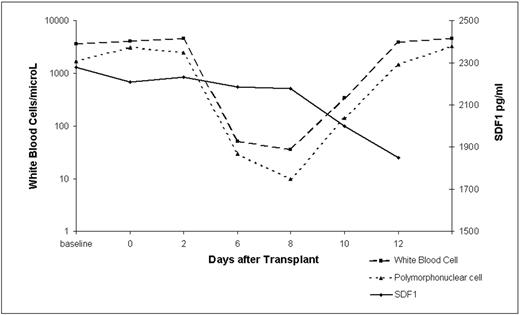Abstract
Abstract 4571
The chemokine stromal-cell derived factor-1alpha (SDF1) is the major chemotactic stimulus for human hematopoietic stem cell (HSC) and through its receptor CXCR4 is critically involved in directional migration and homing of hematopoietic progenitors and stem cells. Usually HSC mobilization is achieved after a proteolytic disruption of SDF1-CXCR4 axis after G-CSF administration. Several report showed HSC circulating during early post transplant phase but the mechanism of recirculation is not clear. Based on these premises we studied the role of SDF1 during autologous peripheral blood stem cell transplant (aPBSCT) and its relations with recirculating HSC and G-CSF administration. From January 2009 to July 2009 we enrolled 12 patients undergoing aPBSCT for hematologic malignancies or solid tumors: 7 males, 5 females, with a median age of 60 years, affected by multiple myeloma (6 patients), Non Hodgkin's lymphoma (5 patients) and Ewing's sarcoma (1 patient). After conditioning regimen (6 Busulfan and Melphalan, 6 High Dose Melphalan) they received a median of 7.56 ×106/kg cell CD34+ on day 0 and, subsequently early (day +1) or delayed (day +6) G-CSF administration. SDF1 was assayed in plasma samples collected at baseline, on day 0,2,6,8,10,12 after aPBSCT using an immunoenzymatic technique. Characteristics of patients of two groups are shown in table 1. There was no statistical difference in CD34+ cell dose infused.
All patients achieved engraftment: neutrophil recovery (PMN count >500 cells/microL) was achieved after a median time of 11 days; platelet recovery (Plt>50×103/microL) after a median time of 14 days; patients were discharged after a median time of 20.5 days. CD34+ cells after transplant were detectable on day +10 (9.06 cells/microL) achieving peak level on day +12 (21.69 cells/microL) confirming timing and magnitude of this phenomenon.
SDF1 assay showed a decrease in concentration from the baseline to hematopoietic engraftment: 2278.3 pg/ml (range 1799.1-3619.6) at baseline and 1850.1 pg/ml on day +12 (range 564.4-2551.7). This decrease in concentration was statistically significant (p=0.0094) and was chronologically related to engraftment ad CD34+ recirculation. We found a statistically significant negative correlation between SDF1 plasma levels and CD34+ cell count after aPBSCT: r=-0.957, p0.043. Interestingly we found a negative correlation between SDF1 plasma levels and white blood cell count starting from day +6 to day +12 (r=-0.91, p=0.03). This finding was confirmed by a positive correlation between SDF1 plasma levels on day +6 and time to achieve a PMN count >500 cells/microL: r=0.67, p=0.01 (Figure 1). The correlations found between SDF1 plasma levels and kinetics of engraftment suggested us to compare engraftment of patients on the base of SDF1 plasma levels. Interestingly patients showing SDF1 plasma levels <2300 pg/ml on day +6 (8 patients) compared to patients with higher levels (4 patients) had a faster PMN recovery in terms of days to achieve a PMN count >500 cells/microL (10.5 days vs 16.5 days, p=0.043), days to achieve a PMN count >1000 cells/microL (11 days vs 18 days, p=0.044) and days with a PMN count <100 cell/microL (5 days vs 12 days, p=0.02). Interestingly taking in to account G-CSF administration schedule, the significant decrease of SDF1 plasma levels observed in whole group of patients was noticed only in patients receiving delayed G-CSF. Patients receiving early G-CSF administration showed small variation of chemochine concentration confirming the key role of G-CSF in perturbing SDF1-CXCR4 axis.
In conclusion our data confirm the involvement of SDF1-CXCR4 axis in post transplant CD34+ recirculation. SDF1 decrease with subsequent CD34+ release may represent a key mechanism to explain repopulation of hematopoietic stem cell niche after myeloablation induced by conditioning regimen. Furthermore there was a clear relation between SDF1 plasma levels and kinetic of engraftment.
Characteristics of patients
| Number of patients . | 12 . | |
|---|---|---|
| sex | 7 male; 5 female | |
| age | 60 years (range 26-65) | |
| diagnosis | A Group 5 NHL 1 ES | B Group 6 MM |
| conditioning regimen | BuMel | HdMel |
| G-CSF starting day | +1 | +6 |
| CD34+x106/kg cells infused | 7.56 (range 3.1-16.6) | |
| Number of patients . | 12 . | |
|---|---|---|
| sex | 7 male; 5 female | |
| age | 60 years (range 26-65) | |
| diagnosis | A Group 5 NHL 1 ES | B Group 6 MM |
| conditioning regimen | BuMel | HdMel |
| G-CSF starting day | +1 | +6 |
| CD34+x106/kg cells infused | 7.56 (range 3.1-16.6) | |
Legend: NHL Non Hodgkin's Lymphoma; ES: Ewing's Sarcoma;
MM: Multiple Myeloma; BuMel: Busulfan and Melphalan;
HdMel:High Dose Melphalan
White blood cell count, neutrophil count and SDF1 assay after transplant.
White blood cell count, neutrophil count and SDF1 assay after transplant.
No relevant conflicts of interest to declare.
Author notes
Asterisk with author names denotes non-ASH members.


This feature is available to Subscribers Only
Sign In or Create an Account Close Modal